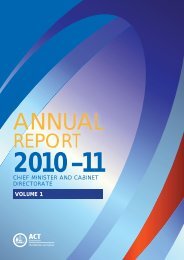Appendix A - Urban Form Analysis: Canberra's Sustainability ...
Appendix A - Urban Form Analysis: Canberra's Sustainability ...
Appendix A - Urban Form Analysis: Canberra's Sustainability ...
Create successful ePaper yourself
Turn your PDF publications into a flip-book with our unique Google optimized e-Paper software.
<strong>Urban</strong> <strong>Form</strong> <strong>Analysis</strong><br />
Canberra’s <strong>Sustainability</strong> Performance<br />
June 2010
<strong>Urban</strong> <strong>Form</strong> <strong>Analysis</strong><br />
Executive Summary - Key Results of the <strong>Analysis</strong><br />
How sustainable is Canberra’s urban form?<br />
What can we learn from Canberra’s existing urban form when designing<br />
new developments and suburbs?<br />
The aim of this analysis is to understand the<br />
performance of Canberra’s existing urban form with<br />
the objective to aid in future decisions about how to<br />
plan Canberra.<br />
This study provides baseline sustainability information<br />
on existing development. This information and the<br />
additional understanding will assist in choosing future<br />
urban forms that use land more effi ciently, conserve<br />
more natural resources, ensure social diversity and<br />
equity and connect to important services such as<br />
transport options, employment opportunities and<br />
community facilities.<br />
ACTPLA has undertaken a comparative analysis of<br />
seven different subdivision patterns in Canberra and<br />
overseas.<br />
Type B - Kingston, Canberra Central<br />
Historic medium to recent high-density, mixed-use development<br />
Comparison of the four Canberra areas<br />
showed that:<br />
��there<br />
is no ‘average’ Canberra suburb with each<br />
area refl ecting the planning philosophy at the time;<br />
��none<br />
of these four areas performs outstandingly<br />
across all of the performance indicators;<br />
��the<br />
Kingston case study area is the most landeffi<br />
cient;<br />
��the<br />
higher density areas in Kingston and Reid use<br />
less land, water and energy per person to provide<br />
housing, open space, pedestrian networks and<br />
other amenities;<br />
��however,<br />
the predominant use of electricity from<br />
the grid to heat apartment buildings in these areas<br />
results in comparatively high greenhouse gas<br />
emissions;<br />
��all<br />
study areas lack diversity in terms of design<br />
and social mix, mix of dwelling types, tenures and<br />
household types.<br />
Type T E E- Hannover, H KKronsberg b GGermany<br />
Visionary urban planning with exceptionally high ecological standards<br />
Four case study areas in Canberra and three<br />
international showcases in urban sustainability<br />
were analysed according to a range of sustainability<br />
indicators in four main themes:<br />
Land Use<br />
Compact layout and effi cient land use<br />
Resource Use<br />
Effi cient energy and water use<br />
Diversity<br />
Housing choice and socio-demographic mix<br />
Connectivity<br />
Movement and amenity<br />
Type C - Gungahlin, Gungahlin<br />
Recent greenfi eld low to medium-density residential development<br />
Type F - Freiburg, Vauban Germany<br />
A model in sustainable urban redevelopment in late 1990’s<br />
Type T G - DDockside k id GGreen, CCanada d<br />
Greenhouse gas neutral harbourside prdevelopment.<br />
Type A - Reid, Canberra Central<br />
Historic low to recent medium-density residential development<br />
Type D - Weston, Weston Creek<br />
1960’s and 1970’s greenfi eld low-density residential development<br />
Key insights from the comparison with<br />
international examples were:<br />
Land use<br />
The overseas examples have two to ten times<br />
more land-effi cient neighbourhood design than the<br />
Kingston case study area, the most land-effi cient of<br />
the Canberra studies. Freiburg Vauban and Dockside<br />
Green reduce their land use for transport by having<br />
perimeter roads and minimising car traffi c within the<br />
development.<br />
Resource use - energy and water<br />
District scale co-generation plants and low-energy<br />
building design reduce the carbon emissions from<br />
operating the dwellings to a level signifi cantly below<br />
the Canberra examples. A publicly visible stormwater<br />
management and rainwater retention concept was<br />
applied across the developments.<br />
Diversity<br />
Hannover Kronsberg showcases diversity in design<br />
by offering a mix of types, tenures and sizes on a<br />
section scale and therefore achieved a balanced<br />
social mix. Freiburg Vauban is dominated by two- to<br />
four-storey row-houses and apartments for families<br />
with children. Dockside Green achieves a narrower<br />
social mix with four to ten storey buildings with one<br />
and two-bedroom apartments.<br />
Connectivity<br />
Car dependency in the international areas is reduced<br />
by providing rapid public transport in combination<br />
with neighbourhoods that have walkable distances<br />
to local essential services and quality design of the<br />
public realm, where pedestrian friendly spaces are<br />
linked and buildings have a diversity of forms and<br />
sizes.
<strong>Urban</strong> <strong>Form</strong> <strong>Analysis</strong><br />
Canberra<br />
Weston<br />
Gungahlin<br />
Reid<br />
Kingston
<strong>Urban</strong> <strong>Form</strong> <strong>Analysis</strong> - Type A<br />
Canberra Example - Reid, Canberra Central<br />
REID is located in the inner north of Canberra. This development was<br />
established in the 1920s according to Garden City principles, characterised by<br />
walkable suburbs where housing is sited within generous open space.<br />
Land Use Comparison Land Use Map<br />
Built <strong>Form</strong> v Open Space<br />
Reid features a range of different building footprint patterns (white);<br />
these patterns are a result of a mix of housing types, including<br />
single detached houses, townhouses and apartment blocks.<br />
Green Space<br />
A generous amount of green space (shown in blue) is created<br />
in Reid through a combination of wide street verges and well<br />
established green private open space.<br />
Building Footprint - 18%<br />
Private Open Space - 35%<br />
Semi Public Open Space - 7%<br />
Road Verge - 24%<br />
Road - 15%<br />
Public Open Space (parkland) - 1%<br />
Private Space v Public Space<br />
Private open spaces (blue) exist both as semi private space facing<br />
the streets, shared apartment courtyard spaces and fully private<br />
individual back yards.<br />
Building Height and Road Reserve<br />
A variety of single (light grey), low rise (mid greys) and multistorey<br />
building heights (black) coexist in Reid. Taller buildings typically<br />
address busier street frontages whilst low rise often face on to<br />
secondary suburban streets.<br />
Typical Garden City suburban housing; low rise detached dwelling surrounded by private open space and wide street verges.<br />
SNAPSHOT<br />
Suburb Reid ACT<br />
Division Canberra Central<br />
Area of tile study 14.4 Hectares<br />
Residential dwellings 519<br />
Study area population 695<br />
Year of initial development 1920’s<br />
Territory Plan zoning<br />
RZ1 Suburban, RZ4 Medium Density Residential, Community Facilities, SZ1 Transport<br />
COMPACT LAYOUT AND<br />
EFFICIENT LAND UTILISATION<br />
Performance indicator Unit of measurement<br />
Population density 48 residents per ha urban area<br />
Gross dwelling density 36 dwellings per ha urban area<br />
Net dwelling density 60 dwellings per ha developable land<br />
Occupancy rate 1.3 occupants per dwelling<br />
Developable land 60% of the urban area<br />
Building footprint 18% of the urban area<br />
Private open space 35% of the urban area<br />
Semi public open space 7% of the urban area<br />
Road reserve 39% of the urban area<br />
Road 15% of the urban area<br />
Verges 24% of the urban area<br />
Public open space 1% of the urban area<br />
Public and semi-public open space 14 m2 per resident<br />
URBAN ECOLOGY, ENERGY AND WATER<br />
Performance indicator Unit of measurement<br />
Annual residential greenhouse gas emissions 5.4 tonnes CO2 per resident<br />
from onsite building operation 7.3 tonnes CO2 per dwelling<br />
Annual residential energy use 22 GJ per resident<br />
30 GJ per dwelling<br />
residential electricity use 4.8 MWh per resident<br />
6.5 MWh per dwelling<br />
residential natural gas use 5 GJ per resident<br />
6 GJ per dwelling<br />
Annual commercial energy use 1.4% of overall energy use<br />
3,835 MJ per m2 commercial space<br />
Annual residential potable water use 86 kL per resident<br />
116 kL per dwelling<br />
Annual commercial potable water use 0.5% of overall potable water use<br />
3.6 kL per m2 commercial space<br />
Ratio pervious to impervious open space<br />
public and private<br />
1.6 pervious : 1 impervious<br />
Green open space 64% of the urban area<br />
public 29% of the urban area<br />
private 35% of the urban area<br />
Tree canopy in the urban area (overall) 36% of the urban area<br />
public 15% of the urban area<br />
private 21% of the urban area
<strong>Urban</strong> <strong>Form</strong> <strong>Analysis</strong> - Type A<br />
Canberra Example - Reid, Canberra Central<br />
Cooyong Cooyong Street Street<br />
Study Area<br />
BRADDON<br />
Ainslie Ainslie Avenue Avenue<br />
REID<br />
DIVERSITY Dwellings and Socio-Demographic Mix<br />
Performance indicator Unit of measurement<br />
Dwelling types in % of overall dwellings<br />
Detached house 4%<br />
Semi-detached or terrace 4%<br />
Apartment 1-2 storey 3%<br />
Apartment 3 storeys 57%<br />
Apartment 4 or more storeys 30%<br />
Dwelling size in % of overall dwellings<br />
1 Bedroom 19%<br />
2 Bedrooms 60%<br />
3 Bedrooms 17%<br />
4 Bedrooms and more 4%<br />
Household composition in % of overall households<br />
single 55%<br />
couple w/o kids 22%<br />
couple with kids 3%<br />
single parent 7%<br />
groups 11%<br />
Population by age cohort in % of overall population<br />
0-19 yrs 12%<br />
20-39 yrs 49%<br />
40-59 yrs 24%<br />
60 yrs and over 15%<br />
Tenure type in % of overall dwellings<br />
Fully owned 13%<br />
Purchased 7%<br />
Rented 76%<br />
Rent/Buy Scheme 0%<br />
Owner occupancy rate 16% of all residents<br />
Public and social housing dwellings<br />
Low income households<br />
16% of all residential dwellings<br />
(gross weekly income less than $650)<br />
High income households<br />
9% of all households<br />
(gross weekly income of $2,500 or more) 9% of all households<br />
CONNECTIVITY Movement and Amenity<br />
Performance indicator Unit of measurement<br />
Distance from centre of study area to:<br />
nearest major public transport node<br />
(bus interchange) 1.2 km walking distance<br />
nearest rapid bus stop 1.8 km walking distance<br />
nearest school 0.5 km walking distance<br />
local shop, group or town centre<br />
nearest green open space (public or<br />
0.5 km walking distance<br />
semi-public) 0.4 km walking distance<br />
Canberra city GPO 1.3 km road distance<br />
Length of bicycle network per ha 5m<br />
Length of pedestrian network per ha 227 m<br />
Intersection density 23 intersections per hectare<br />
CITY<br />
Connectivity<br />
The connectivity image above<br />
indicates how far can you get from<br />
the centre of the study area in a:<br />
5 minute walk<br />
10 minute walk<br />
5 minute cycle<br />
Pedestrians and cyclists can<br />
follow a choice of routes in and<br />
around this urban form, which is<br />
characterised by a high quantity<br />
of pedestrian pathways. A range<br />
of amenities – several educational<br />
facilities, open spaces and shops -<br />
are situated within walking distance<br />
of the Reid study area. The main<br />
city transport interchange is over<br />
1km away.<br />
SUMMARY<br />
High performance<br />
BRADDON AINSLIE<br />
Ainslie Primary<br />
School<br />
People per ha <strong>Urban</strong> Area<br />
Land Take per Person (m 2 )<br />
Public Open Space per Person (m 2 )<br />
Road per Person (m 2 )<br />
Reid<br />
Preschool<br />
Comparative Snapshot<br />
Water use per Person (kL)<br />
CO2 Emissions per Person (t per year)<br />
Low Income Households (%)<br />
400m radius<br />
REID<br />
800m radius<br />
Campbell High<br />
School<br />
CAMPBELL<br />
• Effi cient land use with a population density of 48 residents per hectare and the lowest land-take per person with 206 m2 including<br />
building footprint, open spaces and road corridors.<br />
• High degree of green open space (64 per cent of the urban area) with predominantly pervious surfaces for rainwater penetration and<br />
more than one third of the urban area covered by tree canopies.<br />
• Parks, shops and schools mostly in 5 minutes walking distance with a generous pedestrian network in place.<br />
Moderate performance<br />
• Moderately high potable water use of 86 kL per resident is driven by the high watering requirements of the private gardens in the<br />
suburban blocks of the area.<br />
• Diversity is addressed to a limited degree with 90 per cent of the dwellings being apartments with 2 bedrooms and rental tenure for<br />
medium income households. The age of the population is moderately balanced with the potential to better target families with children.<br />
Low performance<br />
Reid Kingston Gungahlin Weston Hannover Freiburg Dockside<br />
• Mostly electricity operated apartment buildings with reverse-cycle air conditioning and electric hot water appliances performing badly in<br />
terms of carbon emissions (as opposed to gas heating) resulting in 5.4 tonnes of greenhouse gas emissions per resident.
<strong>Urban</strong> <strong>Form</strong> <strong>Analysis</strong> - Type B<br />
Canberra Example - Kingston, Canberra Central<br />
KINGSTON is located in the inner south of Canberra. The area was established<br />
in the 1920s, with newer development extending to the foreshore of Lake Burley<br />
Griffin at the turn of this century.<br />
Land Use Comparison Land Use Map<br />
Built <strong>Form</strong> v Open Space<br />
Kingston is characterised by a range of building footprint sizes<br />
(shown in white), from modest single dwellings through to the larger<br />
footprints created by commercial buildings. .<br />
Green Space<br />
A combination of private and public green space in Kingston<br />
produces a distinctive landscape of green spaces, consisting of<br />
native and exotic established vegetation.<br />
Medium density residential living; Kingston apartments.<br />
Building Footprint - 27%<br />
Private Open Space - 13%<br />
Semi Public Open Space - 3%<br />
Road Verge - 22%<br />
Road - 33%<br />
Public Open Space (parkland) - 2%<br />
Private Space v Public Space<br />
Private open space (in blue) in Kingston varies in size and layout<br />
according to the building type; new apartments share large internal<br />
courtyards and older dwellings are set within modest private yards.<br />
Building Height and Road Reserve<br />
Kingston’s multistorey building heights (mid grey) refl ect the<br />
medium density residential and commercial zoning of the area. The<br />
new Kingston Foreshore buildings increase in height compared to<br />
earlier Kingston developments.<br />
SNAPSHOT<br />
Suburb Kingston ACT<br />
Division Canberra Central<br />
Area of tile study 21.8 Hectares<br />
Residential dwellings 785<br />
Study area population 1018<br />
Year of initial development 1920’s<br />
Territory Plan zoning<br />
RZ5 High Density Residential, CZ1 Core zone, CZ2 Business, CZ5 Mixed Use, PRZ1<br />
<strong>Urban</strong> Open Space, TSZ1 Transport<br />
COMPACT LAYOUT AND<br />
EFFICIENT LAND UTILISATION<br />
Performance indicator Unit of measurement<br />
Population density 47 residents per ha urban area<br />
Gross dwelling density 36 dwellings per ha urban area<br />
Net dwelling density 83 dwellings per ha developable land<br />
Occupancy rate 1.3 occupants per dwelling<br />
Developable land 43% of the urban area<br />
Building footprint 27% of the urban area<br />
Private open space 13% of the urban area<br />
Semi public open space 3% of the urban area<br />
Road reserve 55% of the urban area<br />
Road 33% of the urban area<br />
Verges 22% of the urban area<br />
Public open space 2% of the urban area<br />
URBAN ECOLOGY, ENERGY AND WATER<br />
Performance indicator Unit of measurement<br />
Annual residential greenhouse gas emissions 3.6 tonnes CO2 per resident<br />
from onsite building operation 4.7 tonnes CO2 per dwelling<br />
Annual residential energy use 14 GJ per resident<br />
18 GJ per dwelling<br />
residential electricity use 3.3 MWh per resident<br />
4.3 MWh per dwelling<br />
residential natural gas use 2 GJ per resident<br />
3 GJ per dwelling<br />
Annual commercial energy use 57% of overall energy use<br />
564 MJ per m2 commercial space<br />
Annual residential potable water use 66 kL per resident<br />
129 kL per dwelling<br />
Annual commercial potable water use 43% of overall potable water use<br />
1.5kL per m2 commercial space<br />
Ratio pervious to impervious open space<br />
public and private<br />
1 pervious : 1.7 impervious<br />
Green open space 37% of the urban area<br />
public 16% of the urban area<br />
private 21% of the urban area<br />
Tree canopy in the urban area (overall) 20% of the urban area<br />
public 9% of the urban area<br />
private 11% of the urban area
<strong>Urban</strong> <strong>Form</strong> <strong>Analysis</strong> - Type B<br />
Canberra Example - Kingston, Canberra Central<br />
TELOPEA<br />
PARK<br />
Study Area<br />
Leichhardt Leichhardt Street Street<br />
Giles Giles Street Street<br />
KINGSTON<br />
Wentworth Wentworth Avenue Avenue<br />
Dawes Street<br />
DIVERSITY Dwellings and Socio-Demographic Mix<br />
Performance indicator Unit of measurement<br />
Dwelling types in % of overall dwellings<br />
Detached house 1%<br />
Semi-detached or terrace 4%<br />
Apartment 1-2 storey 23%<br />
Apartment 3 storeys 41%<br />
Apartment 4 or more storeys 30%<br />
Dwelling size in % of overall dwellings<br />
1 Bedroom 12%<br />
2 Bedrooms 73%<br />
3 Bedrooms 15%<br />
4 Bedrooms and more 0%<br />
Household composition in % of overall population<br />
single 40%<br />
couple w/o kids 28%<br />
couple with kids 5%<br />
single parent 3%<br />
groups 21%<br />
Population by age cohort in% of each age cohort<br />
0-19 yrs 6%<br />
20-39 yrs 69%<br />
40-59 yrs 19%<br />
60 yrs and over 7%<br />
Tenure type in % of overall dwellings<br />
Fully owned 9%<br />
Purchased 17%<br />
Rented 73%<br />
Rent/Buy Scheme 0%<br />
Owner occupancy rate 18% of all residents<br />
Public and social housing dwellings<br />
Low income households<br />
1% of all residential dwellings<br />
(gross weekly income less than $650)<br />
High income households<br />
2% of all households<br />
(gross weekly income of $2,500 or more) 50% of all households<br />
CONNECTIVITY Movement and Amenity<br />
Performance indicator Unit of measurement<br />
Distance from centre of study area to:<br />
nearest major public transport node<br />
(bus interchange) 1.7 km walking distance<br />
nearest rapid bus stop 0.2 km walking distance<br />
nearest school 1.0 km walking distance<br />
local shop, group or town centre<br />
nearest green open space (public or<br />
0.1 km walking distance<br />
semi-public) 0.5 km walking distance<br />
Canberra city GPO 5.6 km road distance<br />
Length of bicycle network per ha 1 m<br />
Length of pedestrian network per ha 159 m<br />
Intersection density 27 intersections per hectare<br />
BARTON<br />
Connectivity<br />
The connectivity image above<br />
indicates how far can you get from<br />
the centre of the study area in a:<br />
5 minute walk<br />
10 minute walk<br />
5 minute cycle<br />
Pedestrians and cyclists can follow<br />
a choice of routes in and around<br />
this urban form although dedicated<br />
cycle paths are limited. Connectivity<br />
and proximity to shops and rapid<br />
public transport is excellent with<br />
walking distances of less than<br />
400m. Access to a selection of<br />
educational facilities and open<br />
spaces is also good.<br />
SUMMARY<br />
High performance<br />
Telopea Park<br />
School<br />
GRIFFITH<br />
400m radius<br />
KINGSTON<br />
St Edmunds<br />
College<br />
800m radius<br />
St Clares<br />
College<br />
• Effi cient land use given it is a mixed use area with a population density of 47 residents per hectare and a small land-take per person of<br />
214 m2 including building footprint, open spaces, road corridors and commercial zones.<br />
• With 3.6 tonnes per year the lowest CO2 emissions per resident for operating the dwelling.<br />
• Lowest potable water use per person (66 kL per year) due to low garden watering requirements.<br />
• Shops, parks and rapid bus lines within 5 minutes walking distance and a school within one kilometre walking distance.<br />
Moderate performance<br />
• Despite higher densities and mixed-use zones a higher proportion of pervious green open spaces than the low-density Gungahlin<br />
example.<br />
Low performance<br />
Comparative Snapshot<br />
People per ha <strong>Urban</strong> Area<br />
Land Take per Person (m 2 )<br />
Public Open Space per Person (m 2 )<br />
Road per Person (m 2 )<br />
Water use per Person (kL)<br />
CO2 Emissions per Person (t per year)<br />
Low Income Households (%)<br />
Reid Kingston Gungahlin Weston Hannover Freiburg Dockside<br />
• With predominately rented two bedroom apartments there is a lack of diversity in building types, sizes and tenures.<br />
• Dwellings mainly caters for high-income single or young couples without children and there is a lack of choice for medium income<br />
families with children.<br />
• There is no bicycle network in place.
<strong>Urban</strong> <strong>Form</strong> <strong>Analysis</strong> - Type C<br />
Canberra Example - Gungahlin, Gungahlin<br />
GUNGAHLIN is located 13km north of Canberra Central within the district of<br />
Gungahlin. It’s Canberra’s newest town centre (commencing 1993), and has an<br />
expected final population of 90,000.<br />
Land Use Comparison Land Use Map<br />
Built <strong>Form</strong> v Open Space<br />
Gungahlin is characterised by linear strips of compact buildings<br />
(white) aligned with a regular street pattern. Long strips of built<br />
space are surrounded by narrow strips of open space (blue).<br />
Green Space<br />
Street verges and local park areas (blue) supplement the amount of<br />
private open space available to residents. Plantings throughout the<br />
Gungahlin town centre are both exotic and native.<br />
Gungahlin streetscape framing views to surrounding hills.<br />
Building Footprint - 27%<br />
Private Open Space - 35%<br />
Semi Public Open Space - 0%<br />
Road Verge - 22%<br />
Road - 12%<br />
Public Open Space (parkland) - 4%<br />
Private Space v Public Space<br />
Private open space in Gungahlin (blue) is very compact, consisting<br />
of narrow strips of individual front and rear yards.<br />
Building Height and Road Reserve<br />
A consistent low building height (shown as light grey) is retained<br />
throughout the Gungahlin study area.<br />
SNAPSHOT<br />
Suburb Gungahlin ACT<br />
Division Gungahlin<br />
Area of tile study 18.7 Hectares<br />
Residential dwellings 231<br />
Study area population 617<br />
Year of initial development 1998<br />
Territory Plan zoning<br />
RZ3 <strong>Urban</strong> Residential, PRZ1 <strong>Urban</strong> Open Space, TSZ1 Transport<br />
COMPACT LAYOUT AND<br />
EFFICIENT LAND UTILISATION<br />
Performance indicator Unit of measurement<br />
Population density 33 residents per ha urban area<br />
Gross dwelling density 13 dwellings per ha urban area<br />
Net dwelling density 20 dwellings per ha developable land<br />
Occupancy rate 2.7 occupants per dwelling<br />
Developable land 62% of the urban area<br />
Building footprint 27% of the urban area<br />
Private open space 35% of the urban area<br />
Semi public open space 0% of the urban area<br />
Road reserve 34% of the urban area<br />
Road 12% of the urban area<br />
Verge 22% of the urban area<br />
Public open space 4% of the urban area<br />
URBAN ECOLOGY, ENERGY AND WATER<br />
Performance indicator Unit of measurement<br />
Annual residential greenhouse gas emissions 3.6 tonnes CO2 per resident<br />
from onsite building operation 9.5 tonnes CO2 per dwelling<br />
Annual residential energy use 26 GJ per resident<br />
69 GJ per dwelling<br />
residential electricity use 2.3 MWh per resident<br />
6.0 MWh per dwelling<br />
residential natural gas use 18 GJ per resident<br />
48 GJ per dwelling<br />
Annual commercial energy use n/a<br />
Annual residential potable water use<br />
no commercial uses<br />
76 kL per resident<br />
201 kL per dwelling<br />
Annual commercial potable water use n/a<br />
no commercial uses<br />
Ratio pervious to impervious open space<br />
public and private<br />
1 pervious : 2.3 impervious<br />
Green open space 30% of the urban area<br />
public 11% of the urban area<br />
private 19% of the urban area<br />
Tree canopy in the urban area (overall) 9% of the urban area<br />
public 2% of the urban area<br />
private 7% of the urban area
<strong>Urban</strong> <strong>Form</strong> <strong>Analysis</strong> - Type C<br />
Canberra Example - Gungahlin, Gungahlin<br />
Study Area<br />
GUNGAHLIN<br />
Gundaroo Gundaroo Drive Drive<br />
DIVERSITY Dwellings and Socio-Demographic Mix<br />
Performance indicator Unit of measurement<br />
Dwelling types in % of overall dwellings<br />
Detached house 75%<br />
Semi-detached or terrace 6%<br />
Apartment 1-2 storey 19%<br />
Apartment 3 storeys 0%<br />
Apartment 4 or more storeys 0%<br />
Dwelling size in % of overall dwellings<br />
1 Bedroom 0%<br />
2 Bedrooms 0%<br />
3 Bedrooms 36%<br />
4 Bedrooms and more 64%<br />
Household composition in % of overall households<br />
single 12%<br />
couple w/o kids 25%<br />
couple with kids 51%<br />
single parent 8%<br />
groups 3%<br />
Population by age cohort in % of overall population<br />
0-19 yrs 32%<br />
20-39 yrs 43%<br />
40-59 yrs 21%<br />
60 yrs and over 4%<br />
Tenure type in % of overall dwellings<br />
Fully owned 8%<br />
Purchased 62%<br />
Rented 30%<br />
Rent/Buy Scheme 0%<br />
Owner occupancy rate 71% of all residents<br />
Public and social housing dwellings<br />
Low income households<br />
2% of all residential dwellings<br />
(gross weekly income less than $650)<br />
High income households<br />
12% of all households<br />
(gross weekly income of $2,500 or more) 22% of all households<br />
CONNECTIVITY Movement and Amenity<br />
Horse Horse Park Park Drive Drive<br />
Performance indicator Unit of measurement<br />
Distance from centre of study area to:<br />
nearest major public transport node<br />
(bus interchange) 1.4 km walking distance<br />
nearest rapid bus stop 0.8 km walking distance<br />
nearest school 2.4 km walking distance<br />
local shop, group or town centre<br />
nearest green open space (public or<br />
1.1 km walking distance<br />
semi-public) 0.1 km walking distance<br />
Canberra city GPO 12.6 km road distance<br />
Length of bicycle network per ha 0 m<br />
Length of pedestrian network per ha 172 m<br />
Intersection density 29 intersections per hectare<br />
Yerrabi Pond<br />
Connectivity<br />
The connectivity image above<br />
indicates how far can you get from<br />
the centre of the study area in a:<br />
5 minute walk<br />
10 minute walk<br />
5 minute cycle<br />
AMAROO<br />
The grid network of streets and<br />
paths offers a choice of movement<br />
options within and around the study<br />
area, allowing residents excellent<br />
connectivity to local open spaces.<br />
Connectivity and proximity to other<br />
amenities – education, shops and<br />
public transport – is characterised<br />
by distances over 1km.<br />
SUMMARY<br />
High performance<br />
GUNGAHLIN<br />
Gungahlin Town<br />
Centre<br />
400m radius<br />
800m radius<br />
• With 3.6 tonnes per year the lowest CO2 emissions per resident for operating the dwelling.<br />
• Achieves the most balanced results in terms of social mix of age and income groups and household types, as well as diversity in building<br />
types.<br />
• Pocket parks are distributed well across the area and are in a few minutes walking distance to the dwellings.<br />
Moderate performance<br />
• Given the low density character of the area, due to high occupancy rates it achieves moderate results in population density with 33<br />
residents per hectare and a moderate land-take of 303 m2 per resident.<br />
• Due to smaller gardens and predominantly paved areas there is a fairly low per capita water use of 76 kL per year at the expense of poor<br />
rainwater penetration and a lack of green amenity.<br />
• Rapid bus lines and bus interchange services are within 10 minutes walking distance of the area, the school is within 15 minutes walk.<br />
Low performance<br />
Comparative Snapshot<br />
People per ha <strong>Urban</strong> Area<br />
Land Take per Person (m 2 )<br />
Public Open Space per Person (m 2 )<br />
Road per Person (m 2 )<br />
Water use per Person (kL)<br />
CO2 Emissions per Person (t per year)<br />
Low Income Households (%)<br />
Reid Kingston Gungahlin Weston Hannover Freiburg Dockside<br />
• The second highest average building footprint per dwelling (215 m2).<br />
• Despite low densities and reasonable open spaces, there is a lack of impervious and green open spaces and a lack of mature trees, in<br />
particular in public open spaces.<br />
• Although the pedestrian infrastructure has been put in place, it takes the residents longer to walk to the nearest shops in the town centre<br />
(2,400 m walking distance).
<strong>Urban</strong> <strong>Form</strong> <strong>Analysis</strong> - Type D<br />
Canberra Example - Weston, Weston Creek<br />
WESTON is located west of Canberra Central within Weston Creek. Weston<br />
Creek town centre was established in the late 1960s, with the then National<br />
Capital Development Commission describing Weston Creek as ‘one of the most<br />
picturesque parts of the National Capital’.<br />
Land Use Comparison Land Use Map<br />
Built <strong>Form</strong> v Open Space<br />
Weston Creek features a regular pattern of fi ne grain building<br />
footprints. The built form defi nes linear blocks of open space (roads<br />
and back yards).<br />
Green Space<br />
Weston Creek exemplifi es the 1960s approach to local landscape<br />
development, with buildings set in bushland. Native vegetation is<br />
continued throughout streetscapes and urban open spaces.<br />
Building Footprint - 14%<br />
Private Open Space - 40%<br />
Semi Public Open Space - 0%<br />
Road Verge - 12%<br />
Road - 9%<br />
Public Open Space (parkland) - 25%<br />
Weston Creek sits within a bushland setting which connects to adjacent ridges and buffers.<br />
Private Space v Public Space<br />
Private open space is provided to each dwelling. Generally<br />
consistent setbacks create uniform streetscapes and space at the<br />
front of dwellings, and larger areas of private open space behind.<br />
Building Height and Road Reserve<br />
Building heights are uniformly low rise (light grey). Road reserves<br />
also align with open space corridors.<br />
SNAPSHOT<br />
Suburb Weston ACT<br />
Division Weston Creek<br />
Area of tile study 16.1 Hectares<br />
Residential dwellings 202<br />
Study area population 85<br />
Year of initial development 1970<br />
Territory Plan zoning<br />
RZ1 Suburban, NUZ3 Hills Ridges and Buffer Areas, PRZ1 <strong>Urban</strong> Open Space, TSZ1<br />
Transport<br />
COMPACT LAYOUT AND<br />
EFFICIENT LAND UTILISATION<br />
Performance indicator Unit of measurement<br />
Population density 13 residents per ha urban area<br />
Gross dwelling density 5 dwellings per ha urban area<br />
Net dwelling density 10 dwellings per ha developable land<br />
Occupancy rate 2.4 occupants per dwelling<br />
Developable land 54% of the urban area<br />
Building footprint 14% of the urban area<br />
Private open space 40% of the urban area<br />
Semi public open space 0% of the urban area<br />
Road reserve 21% of the urban area<br />
Road 12% of the urban area<br />
Verge 9% of the urban area<br />
Public open space 25% of the urban area<br />
URBAN ECOLOGY, ENERGY AND WATER<br />
Performance indicator Unit of measurement<br />
Annual residential greenhouse gas emissions 6.4 tonnes CO2 per resident<br />
from onsite building operation 15.4 tonnes CO2 per dwelling<br />
Annual residential energy use 39 GJ per resident<br />
93 GJ per dwelling<br />
residential electricity use 4.7 MWh per resident<br />
11.3 MWh per dwelling<br />
residential natural gas use 22 GJ per resident<br />
52 GJ per dwelling<br />
Annual commercial energy use n/a<br />
Annual residential potable water use<br />
no commercial uses<br />
111 kL per resident<br />
268 kL per dwelling<br />
Annual commercial potable water use n/a<br />
no commercial uses<br />
Ratio pervious to impervious open space<br />
public and private<br />
2.3 pervious : 1 impervious<br />
Green open space 70% of the urban area<br />
public 43% of the urban area<br />
private 27% of the urban area<br />
Tree canopy in the urban area (overall) 37% of the urban area<br />
public 16% of the urban area<br />
private 21% of the urban area
<strong>Urban</strong> <strong>Form</strong> <strong>Analysis</strong> - Type D<br />
Canberra Example - Weston, Weston Creek<br />
WESTON<br />
Study Area<br />
Tuggeranong Tuggeranong Expressway Expressway<br />
DIVERSITY Dwellings and Socio-Demographic Mix<br />
Performance indicator Unit of measurement<br />
LYONS<br />
Dwelling types in % of overall dwellings<br />
Detached house 96%<br />
Semi-detached or terrace 4%<br />
Apartment 1-2 storey 0%<br />
Apartment 3 storeys 0%<br />
Apartment 4 or more storeys 0%<br />
Dwelling size in % of overall dwellings<br />
1 Bedroom 0%<br />
2 Bedrooms 0%<br />
3 Bedrooms 28%<br />
4 Bedrooms and more 63%<br />
Household composition in % of overall households<br />
single 26%<br />
couple w/o kids 31%<br />
couple with kids 43%<br />
single parent 0%<br />
groups 0%<br />
Population by age cohort in % of overall population<br />
0-19 yrs 16%<br />
20-39 yrs 24%<br />
40-59 yrs 34%<br />
60 yrs and over 27%<br />
Tenure type in % of overall dwellings<br />
Fully owned 65%<br />
Purchased 31%<br />
Rented 4%<br />
Rent/Buy Scheme 0%<br />
Owner occupancy rate 92% of all residents<br />
Public and social housing dwellings<br />
Low income households<br />
0% of all residential dwellings<br />
(gross weekly income less than $650)<br />
High income households<br />
0% of all households<br />
(gross weekly income of $2,500 or more) 42% of all households<br />
CONNECTIVITY Movement and Amenity<br />
Performance indicator Unit of measurement<br />
Distance from centre of study area to:<br />
nearest major public transport node<br />
(bus interchange) 1.0 km walking distance<br />
nearest rapid bus stop 1.7 km walking distance<br />
nearest school 0.6 km walking distance<br />
local shop, group or town centre<br />
nearest green open space (public or<br />
1.6 km walking distance<br />
semi-public) 0.2 km walking distance<br />
Canberra city GPO 12.5 km road distance<br />
Length of bicycle network per ha 34 m<br />
Length of pedestrian network per ha 83 m<br />
Intersection density 11 intersections per hectare<br />
HOLDER<br />
Weston Primary<br />
School<br />
Cooleman<br />
Court<br />
STIRLING<br />
Connectivity<br />
The connectivity image above<br />
indicates how far can you get from<br />
the centre of the study area in a:<br />
5 minute walk<br />
10 minute walk<br />
5 minute cycle<br />
Connectivity to open space is<br />
very high within this urban form.<br />
A network of roads and dedicated<br />
cycle paths allows movement<br />
through the study area, although<br />
like Yerrabi the distances to other<br />
amenities such as shops and public<br />
transport are over 1km.<br />
SUMMARY<br />
High performance<br />
WESTON<br />
400m radius<br />
800m radius<br />
LYONS<br />
• A vast amount (70 per cent) of the urban area represents green open spaces with buildings set in bushland, large front setbacks and<br />
generous backyards.<br />
Low performance<br />
Comparative Snapshot<br />
People per ha <strong>Urban</strong> Area<br />
Land Take per Person (m 2 )<br />
Public Open Space per Person (m 2 )<br />
Road per Person (m 2 )<br />
Water use per Person (kL)<br />
CO2 Emissions per Person (t per year)<br />
Low Income Households (%)<br />
Reid Kingston Gungahlin Weston Hannover Freiburg Dockside<br />
• Low population density with only 13 residents per hectare and with 800 m2 per person, nearly four times the land-take of Reid and<br />
Kingston.<br />
• The highest average building footprint per dwelling (270 m2).<br />
• With 6.4 tonnes per year the highest carbon emissions per resident from heating and cooling.<br />
• Highest potable water consumption per resident (111 kL per year) due to watering requirements of generous gardens.<br />
• Narrow housing choices with detached houses for medium to high income households only.<br />
• Aging population with 61 per cent of the population being 40 years and older.
<strong>Urban</strong> <strong>Form</strong> <strong>Analysis</strong> - Type E<br />
International Example - Hannover Kronsberg, Germany<br />
KRONSBERG is located to the southeast of Hannover, the state capital of Lower Saxony.<br />
Developed for the World EXPO 2000 the Kronsberg district presents a comprehensive<br />
example of visionary urban planning and construction with exceptionally high ecological<br />
standards, above-average quality of accommodation and semi-natural open space design.<br />
Land Use Comparison Land Use Map<br />
Built <strong>Form</strong> v Open Space<br />
The appearance of the district is shaped by its wide-meshed rectangular<br />
grid layout, which creates frames for a variety of block structures. The<br />
grid layout of the blocks, the avenue-like streets and the open space<br />
planning unite various construction forms and designs<br />
Green Space<br />
Interconnected public, semi-public and private areas close to the<br />
homes offer differing green and open spaces with rainwater retention<br />
and infi ltration areas integrated in the design. Perimeter developments<br />
with inner courtyards and internal paths offer secluded communal green<br />
spaces and safe play areas for children.<br />
Building Footprint - 16%<br />
Private Open Space - 23%<br />
Vibrant residential development with easy access to open space recreational areas.<br />
Semi Public Open Space - 13%<br />
Road Verge - 29%<br />
Road - 9%<br />
Public Open Space (parkland) - 10%<br />
Private Space v Public Space<br />
Diverse building designs create distinct areas that are grouped around<br />
a neighbourhood park and bordered by park corridors or green zones.<br />
Emphasis is placed on good open space design, and semi-public inner<br />
courtyards and private outdoor areas are available for almost every<br />
home.<br />
Building Height and Road Reserve<br />
Low land take was a key design feature with compact urban form and<br />
perimeter development. Transport Development Areas with maximum<br />
buildings heights of four to fi ve storeys along the light rail corridor<br />
to the north-west links the development with the city. The densities<br />
and buildings heights decrease to two or three storeys towards the<br />
countryside to the south-east.<br />
HANNOVER KRONSBERG currently has a population of around 6,800 people.<br />
The fi rst two development phases, Kronsberg-Nord and Kronsberg-Mitte,<br />
delivered more than 3,000 dwellings. Almost 3,000 jobs are located in the<br />
immediate vicinity with bank and data processing companies. The new<br />
residential area, the adjacent commercial areas with their numerous new<br />
service industry jobs, and the neighbouring countryside create an urban<br />
spatial unity<br />
SNAPSHOT<br />
Suburb Hannover, Kronsberg<br />
Area of tile study 21.4 Hectares<br />
Residential dwellings 810<br />
Study area population 1830<br />
Year of initial development 1999<br />
The following comparison is based on land use data from a study area of 21.4 hectares<br />
located in the northern part of the development (see Aerial Image on the right page).<br />
<strong>Urban</strong> ecology, energy and social data are based on Kronsberg averages. Water data is<br />
based on Hannover average household consumption.<br />
COMPACT LAYOUT AND<br />
EFFICIENT LAND UTILISATION<br />
Performance indicator Unit of measurement<br />
Population density 85 residents per ha urban area<br />
Gross dwelling density 38 dwellings per ha developable land<br />
Net dwelling density 73 dwellings per ha residential area<br />
Occupancy rate 2.3 occupants per dwelling<br />
Developable land 52% of the overall urban area<br />
Building footprint 16% of the overall urban area<br />
Private open space 23% of the overall urban area<br />
Semi public open space 13% of the overall urban area<br />
Road reserve 38% of the overall urban area<br />
Road 9% of the overall urban area<br />
Verge 29% of the overall urban area<br />
Public open space 10% of the overall urban area<br />
URBAN ECOLOGY, ENERGY AND WATER<br />
Performance indicator Unit of measurement<br />
Annual residential greenhouse gas emissions 0.9 tonnes CO2 per resident<br />
from onsite building operation 2 tonnes CO2 per dwelling<br />
Annual residential energy use 16 GJ per resident<br />
36 GJ per dwelling<br />
Annual residential potable water use 51 kL per resident<br />
116 kL per dwelling<br />
The energy concept for the development consists of the following components:<br />
• Low Energy construction methods with quality assurance, monitoring and skills<br />
qualifi cation measures.<br />
• Two decentralised gas-boosted cogeneration plants provide heat for space heating<br />
and warm water for all households.<br />
• Renewable energy sources are utilised: Three wind turbine facilities with an overall<br />
capacity of 3.6 MW, solar collectors and photovoltaic facilities on roofs.<br />
• Innovative technology by solar passive houses, solar district heating, and<br />
microclimate zones.<br />
Main features of the semi-natural decentralised rainwater management system are:<br />
• Rainwater retention basin.<br />
• Hillside avenue to the north with renaturalised watercourse.<br />
• Natural rainwater retention areas.<br />
• Rainwater use concept for inner courtyards.<br />
• Water harvesting and saving concept in school and community centre.
<strong>Urban</strong> <strong>Form</strong> <strong>Analysis</strong> - Type E<br />
International Example - Hannover Kronsberg, Germany<br />
Study Area<br />
KRONSBERG<br />
DIVERSITY Dwellings and Socio-Demographic Mix<br />
Performance indicator Unit of measurement<br />
Dwelling types in % of overall dwelling<br />
Detached house 5%<br />
Terrace or Row Houses 6%<br />
Apartment up to 3 storeys 66%<br />
Apartment 4 to 5 storeys 23%<br />
Household composition in % of overall households<br />
single 39%<br />
couple w/o kids 24%<br />
couple with kids 28%<br />
single parent 9%<br />
groups 21%<br />
Population by age cohort in % of overall population<br />
0-17 yrs 28%<br />
18-59 yrs 64%<br />
60 yrs and over 8%<br />
Low income households<br />
(recieving public transfer services) 37% of all households<br />
CONNECTIVITY Movement and Amenity<br />
The development of Kronsberg followed the regional planning principle, according to<br />
which residential development should occur in the main expand along local rail public<br />
transport routes and be concentrated at urban densities in the catchment areas of the<br />
stops and stations. The three tram stations are within less than 600 metres walking<br />
distance from all the dwellings.<br />
Along the light rail corridor runs the main access road. This transport corridor<br />
became an attractive location for shops and offi ces. At the mid-section of the current<br />
development these uses are concentrated with a shopping centre, a district square, the<br />
‘KroKus’ arts and community centre, a health centre and a church.<br />
Early Delivery of Social Infrastructure<br />
Social infrastructure was put in place concurrently with the housing and includes a<br />
primary school with water saving concept and photovoltaic installation, three children<br />
day care facilities and around 17 units for community use. Community units for<br />
local groups are located on the ground fl oor of apartment buildings as a result of a<br />
compulsory agreement with the developers.<br />
Varied Architecture and Accommodation<br />
Over forty architectural and open space planning offi ces applied very different<br />
approaches and design solutions, in many cases after design competitions.<br />
Balanced Social Mix and Social Infrastructure<br />
Diverse design with a mix of types, tenures and sizes on a fi ne, section scale was<br />
applied to achieve a balanced social mix. Key concepts were fl exible residential design<br />
to cope with changing housing needs, a mixture of large and small apartments, and<br />
apartments suitable for families and for new lifestyles. The objective was to avoid social<br />
segregation by applying various forms of delivery model, tenures and social housing.<br />
BEMERODE<br />
Aerial Image<br />
Image courtesy of Karin Rumming, City of Hannover<br />
Image courtesy of Karin Rumming, City of Hannover<br />
Image courtesy of Karin Rumming, City of Hannover<br />
SUMMARY<br />
Exemplary performance<br />
• Diversity in design and high quality public realm achieves a balanced social mix in terms of household composition (singles, couples,<br />
family with children) and household income (37% low income).<br />
• Early delivery of social infrastructure (school, child care, parks, community spaces) concurrently with housing.<br />
• Landscape design ‘City as a habitat’.<br />
• Low carbon urban design with low energy and passive houses, renewable energy sources, CHP district heating and rapid public<br />
transport.<br />
Web Links<br />
Comparative Snapshot<br />
People per ha <strong>Urban</strong> Area<br />
Land Take per Person (m 2 )<br />
Public Open Space per Person (m 2 )<br />
Road per Person (m 2 )<br />
Water use per Person (kL)<br />
CO2 Emissions per Person (t per year)<br />
Low Income Households (%)<br />
KRONSBERG<br />
http://www.hannover.de/de/umwelt_bauen/bauen/bauen_lhh/oekobauen/oemobakr/modkrons/kroliter/rotebuch.html<br />
http://connectedcities.eu/downloads/showcases/kronsberg_hannover_handbook.pdf<br />
http://www.rudi.net/node/7346<br />
WULFERODE<br />
Reid Kingston Gungahlin Weston Hannover Freiburg Dockside
<strong>Urban</strong> <strong>Form</strong> <strong>Analysis</strong> - Type F<br />
International Example - Freiburg Vauban, Germany<br />
VAUBAN, a former French military base in Germany’s southwest, was<br />
redeveloped as a model sustainable urban district in the late 1990s with a focus<br />
on reduced car use, high ecological standards of buildings and co-building<br />
initiatives to improve affordability.<br />
Land Use Comparison Land Use Map<br />
Built <strong>Form</strong> v Open Space<br />
The housing types include two to four storey row-houses and<br />
apartment buildings. All houses are built to a compulsory low<br />
energy standard, some of them exceeding the performance to<br />
Passivhaus or even Plus Energy Standard. Zoning prohibits the<br />
construction of parking space on the site of the house.<br />
Green Space<br />
To create a landscaped neighbourhood was an explicit design<br />
goal. The design of public green spaces, local streets and the<br />
neighbourhood centre were developed in meetings and workshops<br />
with residents.<br />
Building Footprint - 21%<br />
Private Open Space - 25%<br />
Semi Public Open Space - 9%<br />
Road Verge - 5%<br />
Road - 4%<br />
Public Open Space (parkland) - 36%<br />
Private Space v Public Space<br />
Semi-public spaces such as access galleries, community gardens<br />
and community facilities are a visible feature of the neighbourhood.<br />
Streets and other public spaces are playgrounds for children and<br />
places for social interaction.<br />
Building Height and Road Reserve<br />
The plan departs from the simple inherited grid and creates a<br />
network based on the principle of ‘fi ltered permeability’. The<br />
network geometry favours active modes of transport such<br />
as walking and cycling and disadvantages the car. This is<br />
accomplished by reducing the number of streets that run through<br />
the neighbourhood. Most local streets are shared zones and cul-desacs.<br />
Vibrant mixed density residential development with ease of access to open space and communial green spaces.<br />
FREIBURG VAUBAN’S new district is 41 hectares in size with 1,800 dwellings,<br />
5,000 residents and 600 permanent jobs. It largely consists of two to four<br />
storey row houses and walk-up apartments. Approximately two thirds of<br />
the developments have no garages and front-door parking provisions. As of<br />
2009 around 70% of the households had chosen to live without a private car.<br />
A tram network and two bus lines connect the residents with the surrounding<br />
area. Most individual blocks were sold to small cooperatives of owneroccupiers,<br />
each comprising between 3 and 21 households, which were<br />
responsible for the detailed building design of their shared property. This<br />
generated diverse architectural and open space designs in a fi ne-grain mix of<br />
lot sizes suitable for varying building types from single-family terrace houses<br />
to 20-unit apartment buildings. Besides the owner cooperatives, there is a<br />
number of rental units, both with and without public subsidies.<br />
SNAPSHOT<br />
Suburb Vauban Freiburg, Germany<br />
Area of tile study 11.1 Hectares<br />
Residential dwellings 524<br />
Study area population 1462<br />
Year of initial development 1998<br />
The following comparison is based on land use data from a study area of 11.1 hectares<br />
located in the southern part of the development (see Aerial Image on the right page).<br />
<strong>Urban</strong> ecology, energy, water and social data are based on Vauban averages.<br />
COMPACT LAYOUT AND<br />
EFFICIENT LAND UTILISATION<br />
Performance indicator Unit of measurement<br />
Population density 134 residents per ha urban area<br />
Gross dwelling density 44 dwellings per ha developable land<br />
Net dwelling density 79 dwellings per ha residential area<br />
Occupancy rate 3.1 occupants per dwelling<br />
Developable land 55% of the overall urban area<br />
Building footprint 21% of the overall urban area<br />
Private open space 25% of the overall urban area<br />
Semi public open space 9% of the overall urban area<br />
Road reserve 9% of the overall urban area<br />
Road 4% of the overall urban area<br />
Verge 5% of the overall urban area<br />
Public open space 36% of the overall urban area<br />
URBAN ECOLOGY, ENERGY AND WATER<br />
Performance indicator Unit of measurement<br />
Annual residential greenhouse gas emissions 0.5 tonnes CO2 per resident<br />
from onsite building operation 1.5 tonnes CO2 per dwelling<br />
Annual residential energy use 10 GJ per resident<br />
28 GJ per dwelling<br />
Annual residential potable water use 9 kL per resident<br />
29 kL per dwelling<br />
Impervious open spaces 80%<br />
The energy concept for the development consists of the following components:<br />
• All houses are built to a compulsory low energy standard of 65 kWh/m2 every year<br />
(German Average 1995-2000: 100 kWh/m2, before: 200 kWh/m2).<br />
• 100 four-storey units are designed to an ultra-low energy building standard<br />
(Passivhaus Standard) that has no conventional heating system and uses internal<br />
heat gains, passive solar gains and heat recovery technology.<br />
• A solar district of at least 100 units comprises plus-energy-houses with solar<br />
collectors for heating and photovoltaic systems that produce a surplus of electricity.<br />
The solar energy surplus is then sold back into the city’s grid and provides a profi t<br />
on every home.
<strong>Urban</strong> <strong>Form</strong> <strong>Analysis</strong> - Type F<br />
International Example - Freiburg Vauban, Germany<br />
Study Area<br />
UFFHAUSEN GEWERBEGEBIET SUD<br />
FREIBURG<br />
Giles Street<br />
• Buildings with conventional heating systems are heated by a combined heat and<br />
power station burning wood chips.<br />
The water management concept is based on<br />
• Infi ltration of rainwater into the ground is provided for 80% of the residential areas<br />
• A new ecological sewage system with vacuum pipes to a biogas plant where it<br />
ferments together with organic household waste and generates biogas which is<br />
used for cooking<br />
• Remaining waste water (grey water) is cleaned and reused for gardening, fl ashing<br />
toilets etc.<br />
DIVERSITY Dwellings and Socio-Demographic Mix<br />
Performance indicator Unit of measurement<br />
Dwelling types in % of overall dwellings<br />
2 to 4 storey row houses<br />
and apartments<br />
100%<br />
Household composition in % of overall households<br />
single 12%<br />
couple w/o kids 10%<br />
couple with kids 78%<br />
Population by age cohort in % of overall population<br />
0-17 yrs 30%<br />
18-30 yrs 4%<br />
31-45 yrs 48%<br />
46-60 yrs 15%<br />
60 yrs and over 3%<br />
Low income households 10% of all households<br />
CONNECTIVITY Movement and Amenity<br />
An integrated transport system for the city and the region has achieved the following<br />
modal split:<br />
Walking 21%<br />
Cycling 18%<br />
Public transport 21%<br />
Cars 39%<br />
Motorcycle 1%<br />
Reduced car usage in Vauban is based on:<br />
• A zoning for major parts of the development that prohibits the construction of<br />
parking space on the site of the house. Housing units and parking spaces are sold<br />
separately.<br />
• A liveable street design concept has been applied based on:<br />
• A 30 km/h zone along all main roads through Vauban (as does every residential<br />
street in Freiburg).<br />
• Every road except the main road is a ‘play road’ designed as a 5km/h shared<br />
zone for all residents with pavement widths of 3 to 5 metres and 1 metre wide<br />
pervious and driveable curbs that allow emergency access.<br />
• Bicycle streets that are one way roads for cars and two way streets for<br />
bicycles.<br />
• Pedestrian-only paths that linking residents to nature, retail and public<br />
transport.<br />
• Cars may enter the residential streets but only for loading and unloading purposes.<br />
Residents and visitors, too, are expected to park their car in one of the perimeter<br />
garages and pay for it.<br />
• Car sharing organisation offers its members not only access to cars but also a on<br />
year free pass for public transportation within Freiburg.<br />
• A light rail line runs down the main street with three stations and 8 to 10 services<br />
per hour during peak times. It provides access to the city centre in 13 minutes and<br />
to the central train station in 18 minutes. Interchange opportunities are available<br />
with buses.<br />
UFFHAUSEN<br />
ST GEORGEN<br />
Aerial Image<br />
SUMMARY<br />
Exemplary performance<br />
Reid Kingston Gungahlin Weston Hannover Freiburg Dockside<br />
• Land-effi cient road pattern with only 7 m2 of road corridor per resident due to a liveable street design and car access restrictions<br />
• Low land-take per resident (75 m2) based on minimised road corridor<br />
• Family-friendly compact urban form with 134 people per hectare, two- to four-storey buildings and 80% family households with children<br />
• Low carbon design with energy-effi cient buildings, renewable energy sources, CHP district heating and rapid public transport<br />
Web Links<br />
Comparative Snapshot<br />
People per ha <strong>Urban</strong> Area<br />
Land Take per Person (m 2 )<br />
Public Open Space per Person (m 2 )<br />
Road per Person (m 2 )<br />
Water use per Person (kL)<br />
CO2 Emissions per Person (t per year)<br />
Low Income Households (%)<br />
http://streetswiki.wikispaces.com/Quartier+Vauban,+Freiburg,+Germany<br />
http://www.cabe.org.uk/case-studies/vauban/<br />
http://www.greenlivingpedia.org/Freiburg<br />
FREIBURG<br />
Fig. Concept of fi ltering permeability.<br />
GEWERBEGEBIET SUD
<strong>Urban</strong> <strong>Form</strong> <strong>Analysis</strong> - Type G<br />
International Example - Dockside Green, Canada<br />
DOCKSIDE GREEN is located in the City of Victoria, British Columbia,<br />
Canada. This mixed-use harbourside precinct is designed to be a greenhouse gas<br />
(carbon) neutral development.<br />
Land Use Comparison Land Use Map<br />
Built <strong>Form</strong> v Open Space<br />
Building footprints range in size but all are at an urban scale with<br />
no single detached dwellings. Smaller apartment blocks arranged<br />
in narrow linear bands lie close to the harbour and larger mixed use<br />
buildings distributed opposite an open space corridor.<br />
Green Space<br />
A naturalised creek and pond system or ‘greenway’ runs the length<br />
of the site, terminating in a public amphitheatre. This integrated<br />
storm water and urban ecology system uses native and adaptive<br />
species. Green roofs are also provided on site.<br />
Building Footprint - 26%<br />
Typical Dockside Green development including high density residential built form.<br />
Private Open Space - 13%<br />
Semi Public Open Space - 9%<br />
Road Verge - 9%<br />
Road - 12%<br />
Public Open Space (parkland) - 31%<br />
Private Space v Public Space<br />
Emphasis is placed on shared public spaces. Buildings sit within<br />
a network of larger grain semi-private spaces (building courtyards)<br />
and public open spaces. Private open space is minimal. Mixed use<br />
street frontages encourage outdoor activity within the public realm.<br />
Building Height and Road Reserve<br />
A perimeter road provides access to the site and reduces the need<br />
for on-site road land take. A mix between medium rise and high rise<br />
building heights achieves a high density within a modest site area<br />
whilst still providing a high ratio of public open space.<br />
DOCKSIDE GREEN seeks to be a world-leading model for holistic, closedloop<br />
design, functioning as a total environmental system in which form,<br />
structure, materials, mechanical and electrical systems are interrelated and<br />
interdependent and largely self-suffi cient. When completed, Dockside Green<br />
will showcase energy generating technologies which sustain mixed-use<br />
residential and commercial development including affordable housing, public<br />
open spaces, public art, a mini-transit system, local shops and offi ces. It<br />
achieved LEED Platinum accreditation for stage 1.<br />
SNAPSHOT<br />
Suburb Dockside Green, British<br />
Columbia<br />
Area of tile study 6.05 Hectares<br />
Residential dwellings 1100<br />
Study area population 2200<br />
Year of initial development c. 2006<br />
The following comparison is based on two types of available data: 1. actual performance<br />
data for completed phases of the development and 2. aspirational performance<br />
targets which are planned for but which are not yet completed or data verifying their<br />
performance is not yet published.<br />
COMPACT LAYOUT AND<br />
EFFICIENT LAND UTILISATION<br />
Performance indicator Unit of measurement<br />
Population density 288 residents per ha urban area<br />
Gross dwelling density 144 dwellings per ha developable land<br />
Net dwelling density 144 dwellings per ha residential area<br />
Occupancy rate 2 number of occupants per dwelling<br />
Developable land 48% of the overall urban area<br />
Building footprint 26% of the overall urban area<br />
Private open space 13% of the overall urban area<br />
Semi public open space 9% of the overall urban area<br />
Road reserve 21% of the overall urban area<br />
Road 12% of the overall urban area<br />
Verge 9% of the overall urban area<br />
Public open space 31% of the overall urban area<br />
URBAN ECOLOGY, ENERGY AND WATER<br />
Performance indicator Unit of measurement<br />
Annual residential greenhouse gas emissions 0.2 tonnes CO2 per year<br />
from onsite building operation 0.4 tonnes CO2 per dwelling<br />
Annual residential energy use 7 GJ per resident<br />
15 GJ per dwelling<br />
Annual residential potable water use 37 kL per resident<br />
73 kL per dwelling<br />
Energy concept for the development<br />
A biomass gasifi cation plant will make Dockside Green the fi rst large community-scale<br />
development in North America to be “greenhouse gas neutral” or better from a building<br />
energy perspective. The process uses wood waste recovered from local mills and<br />
woodworking shops, as well as tree trimmings and deadfall from the region.This will<br />
offset emissions created onsite from electricity and the delivery of waste wood to the<br />
site. Excess heat produced by the biomass plant will be sold off-site to neighbouring<br />
businesses.<br />
Building features providing optimised energy performance include passive building<br />
design (shading and daylighting), insulation, low E double-glazed windows, heat<br />
recovery technology to pre-warm incoming fresh air by capturing the heat from<br />
ventilated air being exhausted, a four-pipe fan coil system for domestic hot and cold<br />
water supply system (providing free cooling), photovoltaic and solar hot water products<br />
and wind turbines recycle or reuse 90% of construction waste on site.
<strong>Urban</strong> <strong>Form</strong> <strong>Analysis</strong> - Type G<br />
International Example - Dockside Green, Canada<br />
VICTORIA WEST<br />
Study Area<br />
DOCKSIDE<br />
GREEN<br />
Individual dwelling meters will monitor consumption of cold water, hot water, heat, and<br />
electricity, assisting individual residents to voluntarily conserve energy.<br />
Main features of the water management and treatment systems include:<br />
• The development will treat 100% of its sewage on site and use the treated water for<br />
fl ushing toilets, landscape irrigation and water features.<br />
• Storm water will be treated through green roofs and fl ow via a series of connected<br />
central naturalized creeks and waterways which are key public landscape features.<br />
• Potable water consumption will be minimised by using high performance water<br />
fi xtures and appliances.<br />
DIVERSITY Dwellings and Socio-Demographic Mix<br />
Performance indicator Unit of measurement<br />
Dwelling types in % of overall dwellings<br />
Detached or semi-detached 0%<br />
Terrace or row houses 0%<br />
Apartment up to 3 storeys 5%<br />
Apartment 4 to 5 storeys 95%<br />
Dwelling size in % of overall dwellings<br />
1 Bedroom 53%<br />
2 Bedrooms 43%<br />
3 Bedrooms 4%<br />
4 Bedrooms and more 0%<br />
Population by age cohort in % of overall population<br />
0-17 yrs 0%<br />
18-59 yrs 89%<br />
60 yrs and over 11%<br />
Low income households 10%<br />
Dockside Green is has limited diversity of housing choice in terms of dwelling size or<br />
type, predominately consisting of apartments. Initiatives to promote diverse housing<br />
ownership and affordability include distributing affordable (subsidised) apartments<br />
throughout the site (10%) and constructing energy effi cient buildings with low operating<br />
costs.<br />
CONNECTIVITY Movement and Amenity<br />
The development will provide a range of transport options which connect it to the<br />
nearby downtown area and reduce car use. Features which reduce car reliance and<br />
promote sustainable transport choices include:<br />
• Providing a mixed use urban fabric where people can live, work and access social<br />
infrastructure such as shops.<br />
• A car share program using electric vehicles.<br />
• Upgraded bike trails and bike racks in each building.<br />
• A harbour ferry dock facility.<br />
• Transit and a mini-transit shuttle bus.<br />
• Links and upgrades to existing cycle infrastructure (the Galloping Goose Trail).<br />
Monitoring sustainability performance<br />
Dockside Green has developed a set of performance indicators that will measure the<br />
performance of the project, assessing whether it is achieving its economic, social and<br />
environmental goals. The indicators are to be monitored and results published on an<br />
interactive web page. The City of Victoria will penalise the developer if performance<br />
goals are not achieved. Residential dwellings are also equipped with water and energy<br />
meters which allow them to monitor and adjust their own domestic consumption.<br />
Sustainable development practices<br />
Dockside Green has sought to create a model of how developers, municipalities and<br />
community, environment and business groups can collaborate to create sustainable<br />
developments. Features of this development process model include:<br />
• Community engagement and transparency.<br />
•<br />
Conducting sustainability education programs with schools.<br />
• Supporting local businesses and suppliers which supports the local economy (and<br />
reduces CO2 emissions by minimizing transportation needs).<br />
• Creating local employment.<br />
• Communicating sustainability initiatives and sharing knowledge (publishing, the<br />
internet).<br />
Aerial Image<br />
SUMMARY<br />
Exemplary performance<br />
• Innovative technology applied at a neighbourhood scale (e.g. biomass gasifi cation plant , on-site sewage treatment, green roofs and<br />
naturalised creeks) are presented as a sustainability aesthetic highly visible in the public realm.<br />
• First urban development that achieved LEED platinum accreditation.<br />
• Establishing an online monitoring system accessible for the public that reports and up-dates on the sustainability performance of the<br />
development (http://docksidegreen.visiblestrategies.com/).<br />
Web Links<br />
VICTORIA WEST<br />
VICTORIA<br />
HARBOUR<br />
Comparative Snapshot<br />
People per ha <strong>Urban</strong> Area<br />
Land Take per Person (m 2 )<br />
Public Open Space per Person (m 2 )<br />
Road per Person (m 2 )<br />
Water use per Person (kL)<br />
CO2 Emissions per Person (t per year)<br />
Low Income Households (%)<br />
http://docksidegreen.com/<br />
http://docksidegreen.visiblestrategies.com/<br />
http://www.resourcesmart.vic.gov.au/documents/DockGreenVicCan.pdf<br />
DOCKSIDE<br />
GREEN<br />
VICTORIA<br />
Reid Kingston Gungahlin Weston Hannover Freiburg Dockside


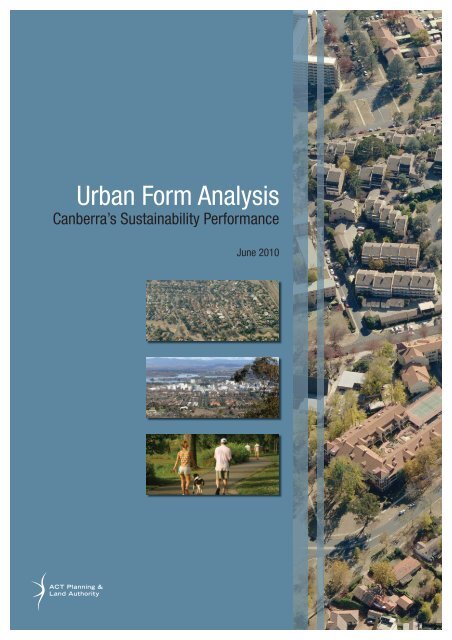
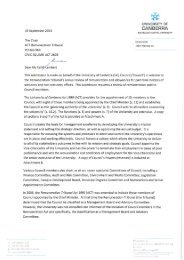
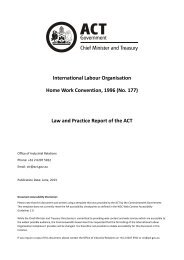
![HSR Training Programs Guidelines [ PDF 191KB]](https://img.yumpu.com/51348280/1/190x245/hsr-training-programs-guidelines-pdf-191kb.jpg?quality=85)


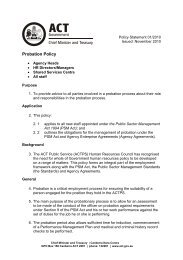

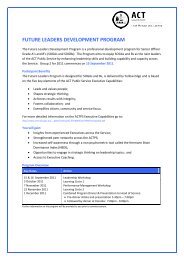


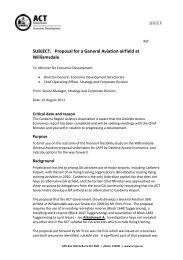
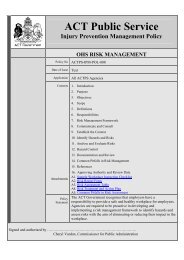
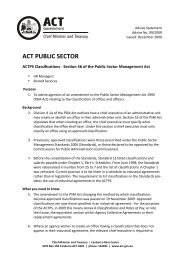
![Teachers Technical and Further Education [ PDF 68KB]](https://img.yumpu.com/34230751/1/184x260/teachers-technical-and-further-education-pdf-68kb.jpg?quality=85)
